Alcoa’s Stock Dropped 70% In 2020 So Far; Could It Crash Another 55%?
Alcoa’s stock (NYSE: AA) has declined 69% since the beginning of this year as the global aluminum prices crashed almost 20% from $1,821/ton in January 2020 to $1,462/ton in May 2020, along with a reduction in demand for aluminum. Additionally, the spread of the novel Coronavirus has also rattled the stock markets and the broader economy. At the current stock price of $7 per share, we believe Alcoa has a significant downside if there are no signs of abatement of the crisis by end of Q2 2020. Alcoa’s stock is already about 88% lower than it was at the beginning of 2018, a little over 2 years ago. We estimate that Alcoa’s stock price could decline to levels of around $3 (worst-case scenario) if its revenues fall by 40% vs. FY’19, its margins remain negative in 2020 (as it continues paying its staff along with incurring other fixed expenses), and its valuation multiple falls to levels of around 0.1x from about 0.3x at the end of FY’19. Below, we summarize this possible downside case for Alcoa, which is detailed in our interactive dashboard analysis Alcoa Downside: How Low Can Alcoa Stock Go?

What’s the likely trigger and timing to this downside?
Alumina (input for aluminum) has been in excess supply from December 2018, which has, in turn, led to a drop in global price levels. Additionally, with an increasing number of aluminum players cutting down on capacity, demand for alumina has remained low, thus putting pressure on pricing.
Though aluminum was in deficit in 2019, this was not reflected in pricing due to a continuous rise in Chinese aluminum exports, which have led to a decline in global price levels. As increasing number of steel players are shedding capacity, and demand from automobiles being modest, China has increased its exports of semi products at a lower price, which has, in turn, led to a decline in the price of primary aluminum products worldwide. The global spread of coronavirus has led to lockdown in various cities across the globe, which has affected industrial and economic activity. The aluminum demand from industry players affects global aluminum price levels, in turn impacting the company’s price realization for its products. Lower demand from construction and automobile players, has led to a drop in global aluminum prices from $1,821/ton in January 2020 to $1,462/ton in May 2020. Also, the new operating model under which Alcoa has put 1.5 million metric tons of aluminum smelting capacity under review, has led to a drop in stock price in anticipation of lower revenue in the coming years.
Alcoa’s Q1 results reflected only partial impact of the crisis, with the company reporting a 12.4% y-o-y drop in total revenues. But we believe Alcoa’s Q2 results in July will confirm the complete impact of the drop in aluminum and alumina prices with a greater hit to its revenue. Specifically, we believe the full-year revenue expectations formed by the market may be closer to $6.3 billion (worst-case scenario), about 40% lower than its 2019 revenue of $10.4 billion, and 53% lower than the 2018 revenue of $13.4 billion. Our dashboard shows key components of Alcoa’s revenues (base-case revenue scenario).
The market isn’t going to stomach this well, and Alcoa’s P/S multiple could remain at its current low of 0.1x, down from 0.3x seen in 2019. The 40% reduction in revenues is unlikely to accompany a proportional reduction in expenses, as compensation expenses and other fixed costs like upkeep of machinery are not expected to see any change. This could result in the net income margin being negative, similar to 2019.
40% lower revenue and loss-making operations leading to almost a 67% drop in P/S multiple (compared to 2019) could translate into Alcoa’s stock price dropping over 55%, taking it close to $3 per share.
Will such a drop be justified? Absolutely not. However, investors who are first out the door in a panic selling situation take a smaller hit to their portfolio.
The actual recovery and its timing hinge on the broader containment of the coronavirus spread. Our dashboard forecasting US COVID-19 cases with cross-country comparisons analyzes expected recovery time-frames and possible spread of the virus. We do believe these trends are likely to reverse in later quarters of 2020, and if the Coronavirus crisis is tamed by the end of Q2, higher revenue and earnings expectations will replace the dire scenarios that are easily imagined during difficult times. Further, our dashboard -28% Coronavirus crash vs. 4 Historic crashes builds a complete macro picture. The complete set of coronavirus impact and timing analyses is available here.
Overall, we believe Alcoa’s stock price at levels of $6 and below provides a good buying opportunity for investors willing to be patient. As per Trefis’ base-case scenario Alcoa’s valuation works out to $9 per share.
See all Trefis Price Estimates and Download Trefis Data here
What’s behind Trefis? See How It’s Powering New Collaboration and What-Ifs For CFOs and Finance Teams | Product, R&D, and Marketing Teams
